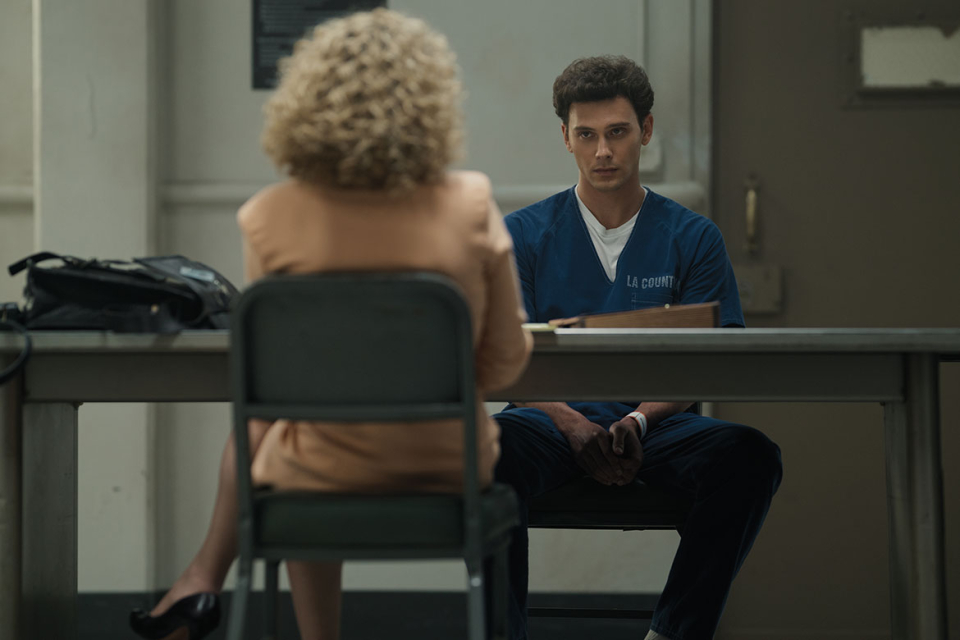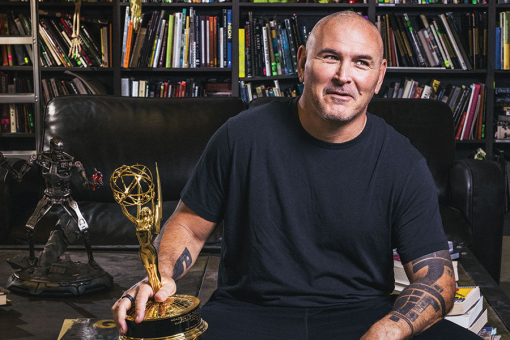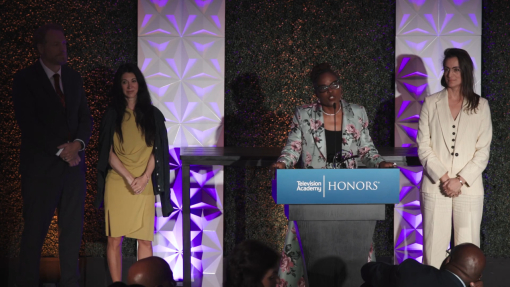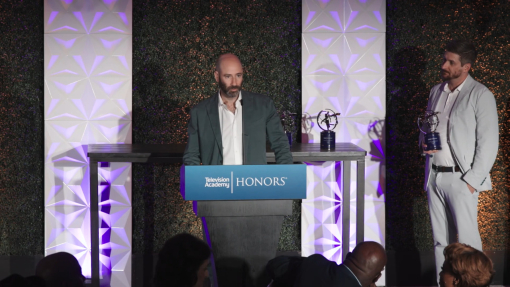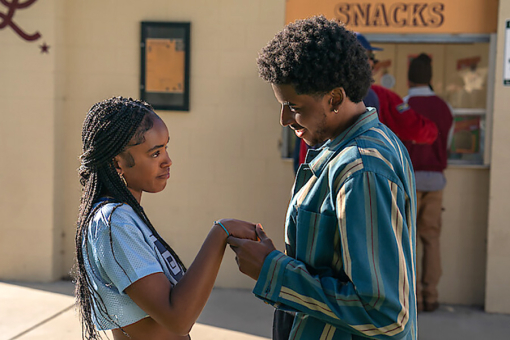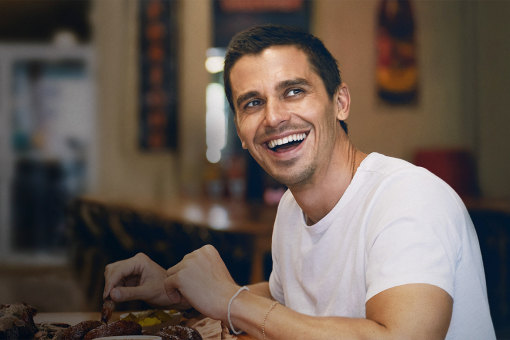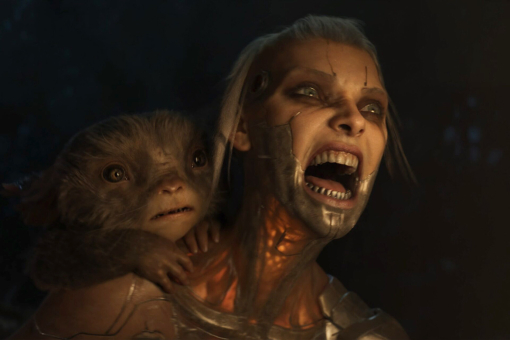Episode five of Netflix's Monsters: The Lyle and Erik Menendez Story, “The Hurt Man,” does something remarkable. The whole episode is a single take (known as a "oner"), with the camera slowly turning our view into an extreme close-up via an almost imperceptible crawl. The austere framing, bold in its simplicity, demands attention be paid as Erik Menendez (Cooper Koch) unravels, divulging to lawyer Leslie Abramson (Ari Graynor) the harrowing reasons why he and his brother murdered their parents.
Here, the cast and crew explain to emmy contributor Jennifer Vineyard how they created an episode that reframes everything we thought we knew about the case.
CLEAR CONCEPTION
Ian Brennan (writer-cocreator-coshowrunner): In 1993, I knew that these kids murdered their parents and cried a lot, because that was the Saturday Night Live sketch. It was stunning to think that no one would have stopped and thought, “Oh, but what were they crying about?”
Ari Graynor (actress, Leslie Abramson): Now it feels ridiculous that anyone can claim boys can’t be sexually abused.
Brennan: It just wasn’t something that anyone could wrap their head around.
Cooper Koch (actor, Erik Menendez): I asked the casting directors, “Is there an episode called ‘The Hurt Man’?” I knew about Erik calling himself that. I just knew intuitively that there would be an episode called that.
Brennan: On the Thursday before the writers’ strike, I got an email from [cocreator] Ryan [Murphy] asking, “What’s your pitch for episode five?” I kept going back to the fact that the trial is a snooze, except when Erik and Lyle testify about the abuse, and then it’s riveting. It’s a single angle. It’s a locked-off shot. It’s terrible video, but you cannot look away. I was like, “I wish we could capture that. We have to figure out a way that we don’t let the audience look away.” So, I pitched it to Ryan. Ryan was like, “Can you write that by Sunday?”
That night, I poured myself a glass of wine and wrote it. It was the most artistically pure thing I’ve ever done. It just came out in a flow state. When I look back on my deathbed, what will be the best thing I’ve ever done? That night on the sofa.
Graynor: It’s not a surprise that Ian used to be an actor before he was a writer. He has a deep understanding of the internalization an actor has. It was written with such nuance, in the voices of these two characters.
Koch: When I read the episode, I was like, “Wow, this is what Erik sounds like.” I could just hear it.
Brennan: I knew it was good, because I was crying. I cried when Erik comes to the realization that he’s been irrevocably broken. “The hurt man” — that was a real thing. He became his own trauma.
Koch: Ian captured it so perfectly, how someone who’s been through something like this doesn’t necessarily know how to tell it in a straightforward fashion. It comes out all jumbled and confusing.
SECOND THOUGHTS
Brennan: Reading it back, I was like, “Leslie’s in this a lot. Is that going to work? Because we’re going to be on her back.”
Michael Uppendahl (director): You get a glimpse of who Leslie is as she comes in. The way she puts her bags down, the way she has her cigarette, it tells you a lot.
Brennan: Cut to a long interminable strike, then the strike’s over. Finally, we’re shooting, and getting rumblings from very well-meaning producers: “Could we maybe turn around on it just in case? Can we do the same really slow push-in on Ari?”
Koch: I remember [cinematographer] Jason McCormick and I went into the room, and he was like, “Maybe we float around the room and end up on Leslie at some point, too.” Just spitballing ideas. But I was always like, “I think we should do it how it’s written.”
Uppendahl: People were concerned that you couldn’t cut between takes. I thought, “Let’s just go for it.”
Matthew Flood Ferguson (production designer): We ended up building a few wild walls, removable walls, hoping that one of them would work for Jason's camera placement. I designed a center room that had an interior casement window on a hinge, so that it was almost like a big door that could open up. We were still discussing where the table would be — in the center of the room, off in a corner or on one wall — up until the rehearsal. That's when Jason was able to place his crane camera outside the set and slowly push in.
Koch: I was like, "Okay, I know I can do this, because I've done theater."
Graynor: I thought we were going to rehearse it like a play.
Uppendahl: Had this been a play, I would have rehearsed it for weeks. My biggest concern was to make sure both Ari and Cooper were off-book verbatim. I never considered a teleprompter.
Koch: They asked me if I wanted a teleprompter, but I said no. That would take me out of the moment.
Graynor: It never even occurred to me to want to have a safety net. All of it was complete surrender to this experience.
Uppendahl: I’ll never forget the rehearsal. I thought, “The key to this is that Ari has to feel as equal as Cooper, or it’s all going to fall apart.”
Brennan: When they got to the end of the rehearsal, the room was just silent. I was completely floored.
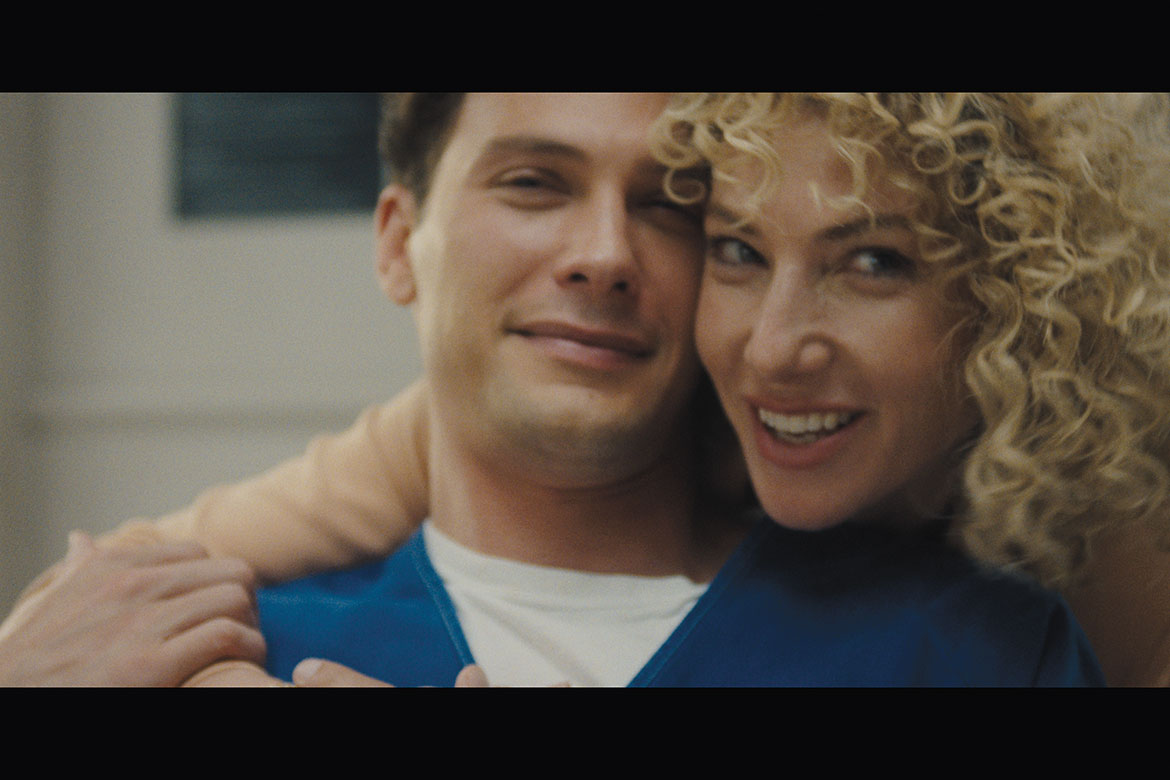 A still photo of Koch and Graynor from episode five was illustrated and became a wrap gift for the show’s crew. Photo by: Miles Crist/Netflix
A still photo of Koch and Graynor from episode five was illustrated and became a wrap gift for the show’s crew. Photo by: Miles Crist/Netflix
CRANE TECHNIQUE
Uppendahl: I actually rehearsed the crane more than I rehearsed the actors.
Brennan: There's not a dolly grip in Hollywood who can actually move a camera that slowly. We needed to get a motion control machine that had probably never been used for slow motion, and set it on the lowest level.
Uppendahl: Motion control cranes are loud, and what we needed was something silent, so we found the most silent machine available, which was still loud.
Brennan: They had to build this whole rig to baffle the sound.
Uppendahl: It looked like this strange little monster moving forward with this elaborate skirt. We had to have control of the head so that the camera could move, which is the opposite of the intention of a machine like that, so they had to reprogram it.
Koch: I felt emotionally connected to the camera. I remember thinking of the camera like, "There are all these people who have experienced this and will see themselves."
Uppendahl: I would have Cooper sit in the chair for a long time, and I gave Ari a silent cue of when to enter, so he would be surprised when that would happen. And I had the extras walking back and forth so that he could think, "Oh, this is going to be Ari," and then it wouldn't be.
Graynor: We did it four times all the way through over two days. I guess there were two false starts.
Uppendahl: There was one take that did have a technical problem. And there was one take that I could just feel was not going to work out as well, and I was terrified that if we laid one down that wasn’t great, the whole house of cards would fall apart. So, I called, “Cut!” and blamed our crane.
CHASING THE DRAGON
Koch: The first two takes, I was trying to recreate what the rehearsal was, which is the killer of creativity. I was just really disappointed in myself. Ari came to my trailer, and we had a cry. Before we went into the third take, I told Michael, "I need help. It's not coming out."
Uppendahl: I said, "You're chasing the dragon" — chasing the initial high. You're never going to get it again, nor should you. You have to build it anew every time. And I told him to listen to Ari. She's the key.
Brennan: Ari is so present that you get her performance through Cooper, even though you're on him the whole time.
Koch: Watching her behavior, it was so specific and true to Leslie. When she would write something down, how she shifted in her seat, when she would touch her hair. It's like the behavior just comes so organically. It kept me in the moment. I would be like, "Oh, did that make her uncomfortable?"
Graynor: Ian spoke about this episode being when Leslie became Erik's mother, in a way. My job was to listen with as much presence as humanly possible. I felt like it was this incredible model of what it is to hold space for someone to be heard for the first time.
Koch: In the first couple takes, I made the choice to not look at her. I thought it would be difficult for Erik to look her in the eyes. So, Michael was like, "Be really open. Look at her. Try and defend your parents. Try and find as much light as you can."
Uppendahl: These felt like actionable pieces. If you get the right note, then the dominoes fall down.
Koch: That really opened me up to the moment and to the reality of the pain and what Erik wanted from his parents, which was love and acceptance. That third take was so explosive.
Graynor: After the third take on the first day, there was this feeling of "We did it!" I remember being surprised when Michael was like, "Let's go again."
Koch: Day one was a Thursday, and the other unit was shooting episode six on the other soundstage while we were doing episode five. It felt chaotic. Day two was a Sunday, and no one was on the soundstages except for us. There was something magical about it happening when no one else was there.
Uppendahl: We could have used any take from Thursday, but this felt like it was going to be a rare event, and it just kept getting better. It felt like we were playing hooky.
Koch: I looked at stills from the first day, from the very last shot. My face was angled toward Leslie, so it was almost in profile. I knew it just didn't look cinematic enough. So, on the second day, I made sure that at the end shot, my face was angled toward the camera, and then I could use my eyes to look at her.
Graynor: Each one of those eight takes was entirely different. After the two false starts, there was no sense of destination or "I've got to hit this in this way." It was just subtlety, modulation of different emotional heights, rhythm, all of that. Ultimately, they ended up choosing take eight, our final take.
Koch: That last one, we were really trying new stuff. I remember Michael saying to us, "This is the last one. Go for it." It took the pressure off.
Graynor: There's one ad lib in that take — me saying, "Look at me."
Koch: I get chills thinking about that moment. What an amazing, organic, authentic choice. So powerful.
Graynor: I think the freedom of that last take gave us that.
Koch: I remember Ryan telling me he wanted me to give that look at the end, like, "Anything else?" I never wanted it to be a kitschy gotcha: "Oh, is he lying? Did he just make all that up?" I genuinely looked back at her to see if she was going to ask another question.
Uppendahl: I didn't want to end with a take that wasn't magical. I just knew we had it. I wanted us to end on top of the mountain. It's rare that you get two actors who are so willing to climb together to unknown heights.
Brennan: It ended up being this crazy unicorn of an experience. If this show, this episode, plays a hand in getting the Menendez brothers a new sentencing hearing, I would say this is probably the most impactful episode of television I will ever be involved in. Full stop. That just shows you the power of television.
Monsters: The Lyle and Erik Menendez Story is now streaming on Netflix.
This article originally appeared in emmy magazine, issue #4, 2025, under the title "A Long Shot."



